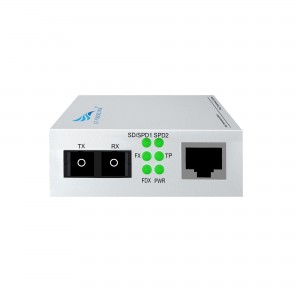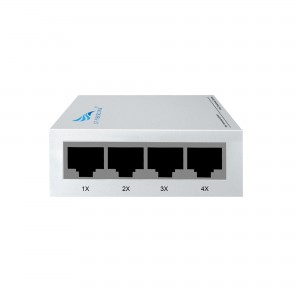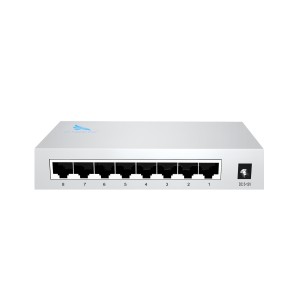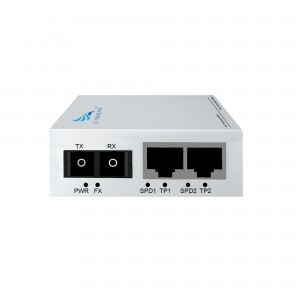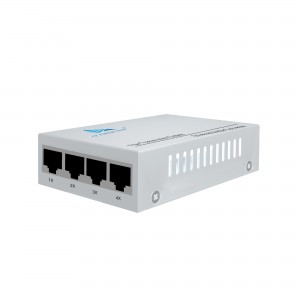3-port 10/100M WDM Media Converter (Single-mode Single-fiber SC)
3-port 10/100M WDM Media Converter
Product Features:
Introducing Cutting-Edge 1 Optical 2 Electrical Single-Mode Single-Fiber Transceiver: A Game Changer for Optical-to-Optical Conversion Technology
Changfei Optoelectronics Technology Co., Ltd., a leading provider of advanced transmission solutions, proudly presents its latest innovation – 1 optical 2 electrical single-mode single-fiber transceiver. With our unwavering commitment to providing high-quality products and excellent service to customers worldwide, we have received more than 360 honors in more than 100 countries. Experience the future of photoelectric conversion with our distributors and agents.
Our 1-optical 2-electrical single-mode single-fiber transceiver is a breakthrough product that seamlessly combines the functions of transceiver and optical-to-electrical converter. This cutting-edge device is specifically designed to meet the demands of modern networking applications, revolutionizing data transfer capabilities.
Our transceivers feature a compact and ergonomic design, providing the perfect solution for high-density network environments. Its state-of-the-art technology enables you to convert optical signals to electrical signals and vice versa, ensuring seamless and efficient data transfer.
One of the main functions of our transceivers is to support power and network ports. With a wide voltage power supply that can withstand up to 4KV reverse demand, it can guarantee reliable and stable performance even under challenging conditions. In addition, the device supports DC512V power input and is compatible with various power sources.
The 1-optical 2-electrical single-mode single-fiber transceiver also boasts an impressive 10KB jumbo plug-and-play support for easy installation and configuration. Say goodbye to complicated setup processes and hello to easy network integration. Plus, its rack-mount capability offers flexibility and convenience to perfectly fit your infrastructure requirements.
At YOFC, customer satisfaction is our top priority. We invest heavily in research and development to ensure our products deliver innovative features and unrivaled performance. Our transceivers have a strong scientific patent portfolio and a rich history of successful experiments, a testament to our dedication to excellence.
Experience a new era of optical to optical conversion technology with our 1 Optical 2 Electrical Single Mode Single Fiber Transceiver. Reinvent your network’s capabilities and enable seamless data transfers like never before. More and more global customers trust YOFC’s cutting-edge solutions.
Choose innovation. Choose reliability. I believe that YOFC will change your network experience.
What This Product Does ◇ CF-1012SW-20A is a Hundred megabytes media converter, providing a Hundred megabytesRJ-45 port and a Hundred megabytes SC fiber port, which can convert between electrical and optical signals. How This Product Works ◇ CF-1012SW-20A adopts WDM (wavelength division multiplexing) technology, helping send and receive data at a distance of up to 20 km with only a single mode fiber, which saves half of the cable deployment cost for customers. CF-1012SW-20A transmits data at 1310 nm wavelength and receives data at 1550 nm wavelength on optical fiber. Therefore, the terminal device used in conjunction with the CF-1012SW-20A should send data at a wavelength of 1550 nm and receive data at a wavelength of 1310 nm. CF FIBERLINK another media converter CF-1012SW-20B is one of the products that can cooperate with CF-1012SW-20A. Other Features ◇ Besides, this media converter can be used as a standalone device (no rack required) or used with CF FIBERLINK’s CF-2U14 rack for auto MDI/MDI-X in TX port in which duplex mode is automatically negotiated.
Technical Parameter:
| Model | CF-1012SW-20A | |
| Interface Characteristics | ||
| Fixed Port | 2* 10/ 100Base-TX RJ45 port1* 155M uplink SC fiber port | |
| Ethernet Port | 10/ 100Base-TX auto-sensing, full/half duplex MDI/MDI-X self-adaption | |
| Twisted PairTransmission | 10BASE-T: Cat3,4,5 UTP(≤100 meter)100BASE-T: Cat5e or later UTP(≤100 meter) | |
| Optical Port | Default optical module is single-mode single-fiber 20km, SC port | |
| Wavelength/Distance | A-end: RX1310nm / RX1550nm 0 ~ 40KMB-end:RX1550nm/ RX1310nm 0 ~ 40KM | |
| A-end: RX1490nm / RX1550nm 0 ~ 120KMB-end:RX1550nm/ RX1490nm 0 ~ 120KM | ||
| Chip Parameter | ||
| Network Protocol | IEEE802.3 10BASE-T, IEEE802.3i 10Base-T,IEEE802.3u 100Base-TX, IEEE802.3u 100Base-FX, IEEE802.3x | |
| Forwarding Mode | Store and Forward(Full Wire Speed) | |
| Switching Capacity | 0.6Gbps | |
| Buffer Memory | 0.45Mpps | |
| MAC | 1K | |
| LED Indicator | Fiber | SD/SPD1 (green) |
| rate | SPD2: 10/ 100 (green) | |
| Data | FX(green)/TP (green) | |
| FDX (green) | ||
| Single / duplex | ||
| Power | PWR (green) | |
| Power | ||
| Working Voltage | AC:100-240V | |
| Power Consumption | Standby<1W, Full load<3W | |
| Power Supply | DC:5V/2A industrial power supply | |
| Lightning protection &Certification | ||
| Lightning protection | Lightning protection: 4KV 8/20us, Protection level: IP30 | |
| Certification | CCC;CE mark, commercial; CE/LVD EN60950;FCC Part 15 Class B; RoHS | |
| Physical Parameter | ||
| Operation TEMP | -20~+55°C;5%~90% RH Non condensing | |
| Storage TEMP | -40~+85°C;5%~95% RH Non condensing | |
| Dimension (L*W*H) | 94mm* 71mm*27mm | |
| Installation | Desktop, CF-2U14 slot rack | |
Product Size:
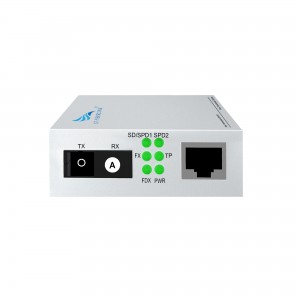
product application diagra:

How to choose a fiber optic transceiver?
Optical fiber transceivers break the 100-meter limitation of Ethernet cables in data transmission. Relying on high-performance switching chips and large-capacity caches, while truly achieving non-blocking transmission and switching performance, they also provide balanced traffic, isolation and conflict. Error detection and other functions ensure high security and stability during data transmission. Therefore, fiber optic transceiver products will still be an indispensable part of actual network construction for a long time. So, how should we choose fiber optic transceivers?
1. Port function test
Mainly test whether each port can work normally in the duplex state of 10Mbps, 100Mbps and half-duplex state. At the same time, it should be tested whether each port can automatically select the highest transmission speed and automatically match the transmission rate of other devices. This test can be included in other tests.
2. Compatibility test
It mainly tests the connection ability between the optical fiber transceiver and other devices compatible with Ethernet and Fast Ethernet (including network card, HUB, Switch, optical network card, and optical switch). The requirement must be able to support the connection of compatible products.
3. Cable connection characteristics
Test the fiber optic transceiver’s ability to support network cables. First, test the connection ability of Category 5 network cables with lengths of 100m and 10m, and test the connection ability of long Category 5 network cables (120m) of different brands. During the test, the optical port of the transceiver is required to have a connection capability of 10Mbps and a rate of 100Mbps, and the highest must be able to connect to a full-duplex 100Mbps without transmission errors. Category 3 twisted pair cables may not be tested. Subtests can be included in other tests.
4. Transmission characteristics (transmission loss rate of data packets of different lengths, transmission speed)
It mainly tests the packet loss rate when the optical fiber transceiver optical port transmits different data packets, and the connection speed under different connection rates. For the packet loss rate, you can use the test software provided by the network card to test the packet loss rate when the packet size is 64, 512, 1518, 128 (optional) and 1000 (optional) bytes under different connection rates. , the number of packet errors, the number of packets sent and received must be more than 2,000,000. Test transmission speed can use perform3, ping and other software.
5. The compatibility of the whole machine to the transmission network protocol
It mainly tests the compatibility of fiber optic transceivers to network protocols, which can be tested in Novell, Windows and other environments. The following low-level network protocols such as TCP/IP, IPX, NETBIOS, DHCP, etc. must be tested, and the protocols that need to be broadcast must be tested. Optical transceivers are required to support these protocols (VLAN, QOS, COS, etc.).
6. Indicator status test
Test whether the status of the indicator light is consistent with the description of the panel and the user manual, and whether it is consistent with the current status of the fiber optic transceiver.








